The Marathons go home after meeting in SGN, and home meant TPE for me and CDG for my wife at that time. A direct flight to each airport? It would have been too easy.
Mrs. Marathon's return to Paris should have been simple : a direct AF night flight on Sunday evening. But three months before the vacation, we received an e-mail from the travel agency: the SGN-CDG AF flight was now a day flight, leaving in the morning. That cancelled our last day of vacation together, and furthermore, my own plane ticket (a FB award Classic ticket) was not very flexible. Maybe I could have negotiated that, since the cause was a schedule change of an AF flight. Plan B has been to have her leave on a domestic VN flight to HAN, connecting with a night HAN-CDG VN flight, codeshared with AF.
For me, the last direct SGN-TPE flight was at 17:45, nearly six hours before the AF flight when it was a night one. My strategy has therefore been to choose a connecting Skyteam route, whose first leg was as long as possible (to sleep) and the second leg as short as possible (to arrive in Taipei not too late).
Geometrically, the optimum was that three airports be aligned on the great circle route, which meant that I should connect somewhere in Japan. The routing via NGO that the advantage of being a good compromise duration of sleep versus arrival time in TPE, with the bonus of the discovery of a new airport. The FB fare in airmiles was the same, albeit with more expensive airport taxes, which made this unusual routing worth it.
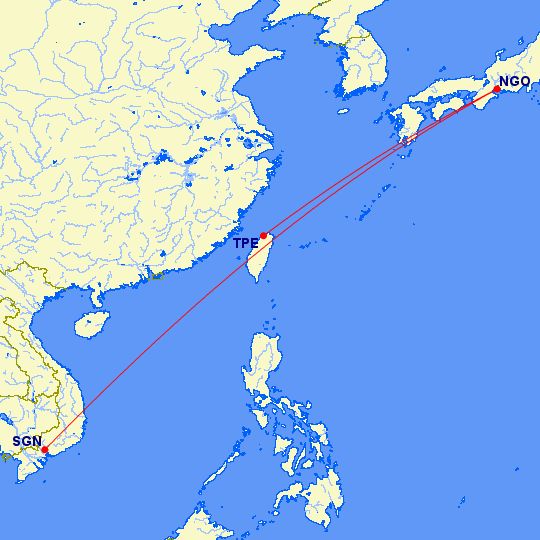
Thanks to gcmap.com
(By the way, I wonder how many people know that Tokoname Chubu Centrair is really Nagoya's new international airport. Granted, Chubu is the Japanese name for that region, but only the Japanese know that.)
This FR begins in the hall of our hotel in Saigon, as the Vietnamese keep calling that city, with a corporate screenshot to set the mood. Japanese tourists have left their golf clubs on the left. I changed clothes in the toilets, indicated by an overhead sign above the customer on the right…

… whose pictograms were very local

It was a trouble-free taxi ride to SGN's domestic terminal, only that I had neglected that the driver would add the expressway' toll to the bill. I had miraculously enough in cash to pay him, leaving only 2,000 VND left in my wallet. I would not go on a shopping spree in SGN's duty-free shops with that: it was worth around 10 US cents. That was my best estimate ever of my needs in cash abroad.

In principle, only passengers have access to the terminal, but nobody checks anything.
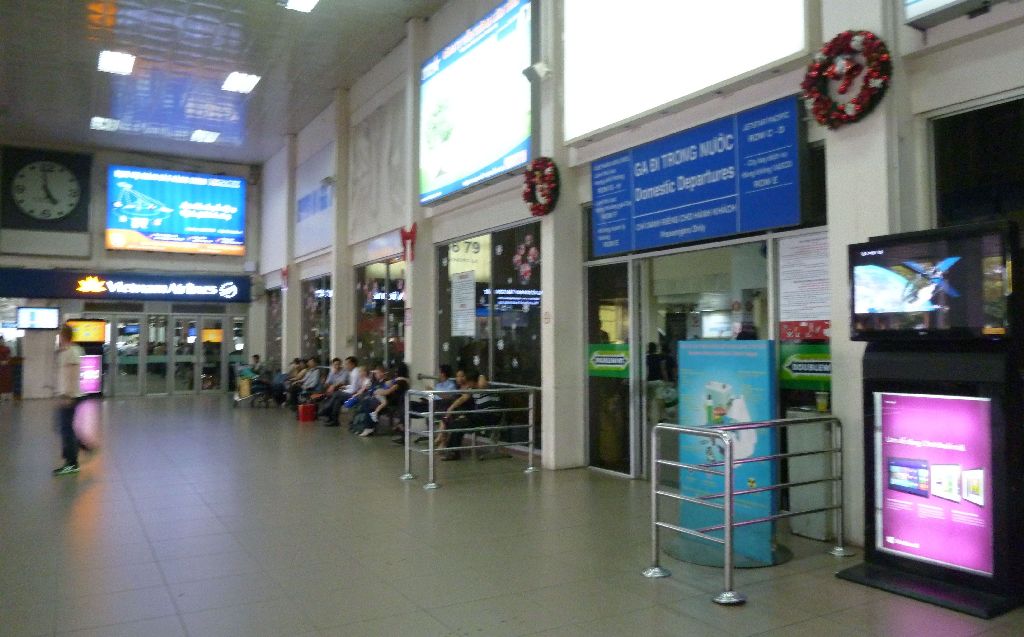
(sorry, the picture is quite blurry)

Anyway, SNG1's landside area is not very attractive. Mrs. Marathon's FB Gold card provides her the business check-in counters.

There was a VN captain at the check-in

… and in the background a VN FA, both in uniform. Deadheading? Possibly, but they were waiting in line like all other passengers, and there will be no airline staff bashing this time.
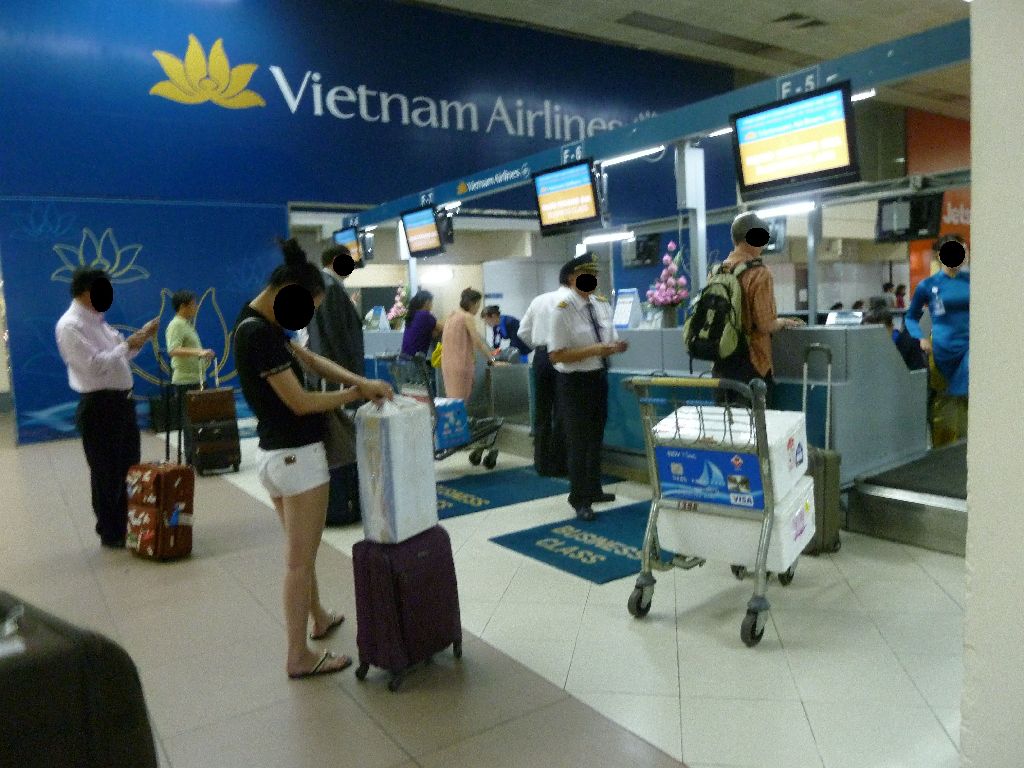
Mrs. Marathon was flying economy on that domestic flight, and had therefore a 20kg checked luggage allowance. Be it cash or luggage, our estimates were perfect. Even though the excess luggage fee on a domestic flight is a desultory 40,000 VND per kg (1,5 EUR !!), my 2,000 leftover VND could only pay for 50 grams of excess luggage. Actually, I also had cash in USD and credit cards, both of which are easily accepted in a Vietnamese airport or a taxi of the same nationality.

After leafing through her passport at great length, Mrs. Pham Luu Ly eventually asked Mrs. Marathon its date of validity. The date of expiry of the passport is in the identity page of course, but what she actually wanted was the expiry date of the Vietnamese visa that she could not find in that passport overflowing with page after page of ideograms in stamps and visas. A Vietnamese has an easily recognizable design, though.
Anyway, the suitcase was checked all the way to CDG with a priority luggage tag; she would only need to obtain in HAN her boarding pass for the connecting flight. There was no connection counter in HAN, arriving by on a domestic flight: Mrs Marathon arrived landside and checked in like any other passenger at the Departures level.
I only needed to walk to the international terminal using this path that we had taken in the reverse direction two weeks earlier after meeting in SGN.
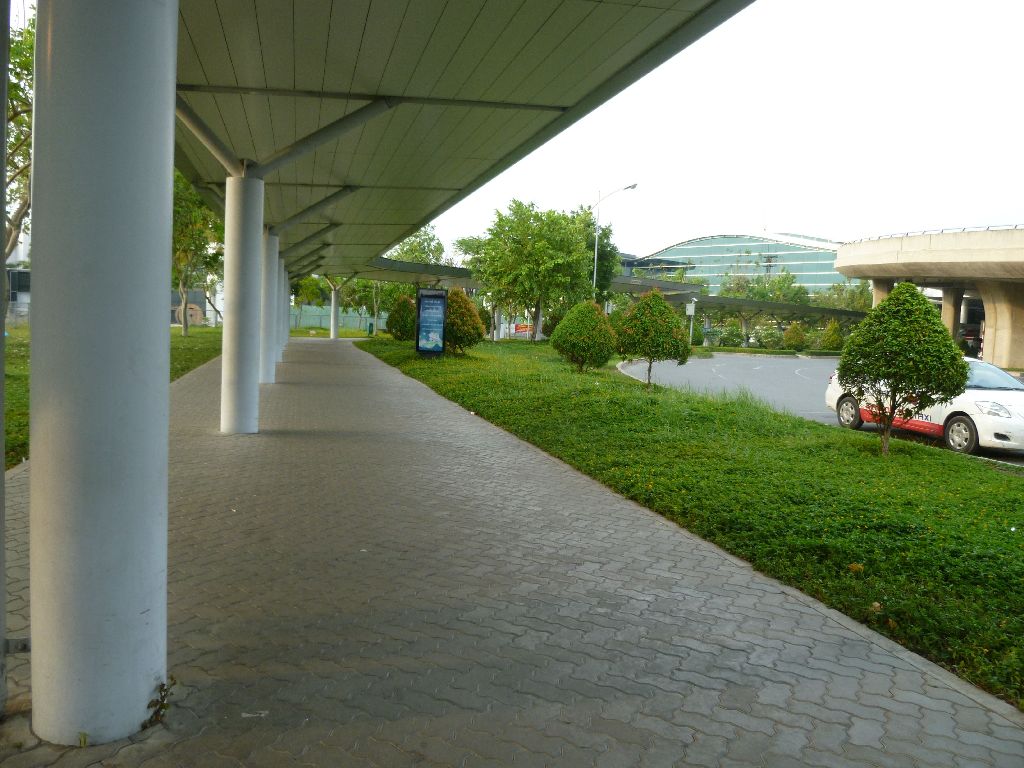
… and find out that my flight was going to be the last but one out of SGN.

… so late that it was too early to check in: come back at 18:00. In other words, forget about plane spotting in daylight, when I could have spent an extra hour with my wife before it was time for her to go through the domestic terminal's security check.

Landside, despite huge lateral windows, there is really not much to put in front of one's lenses.
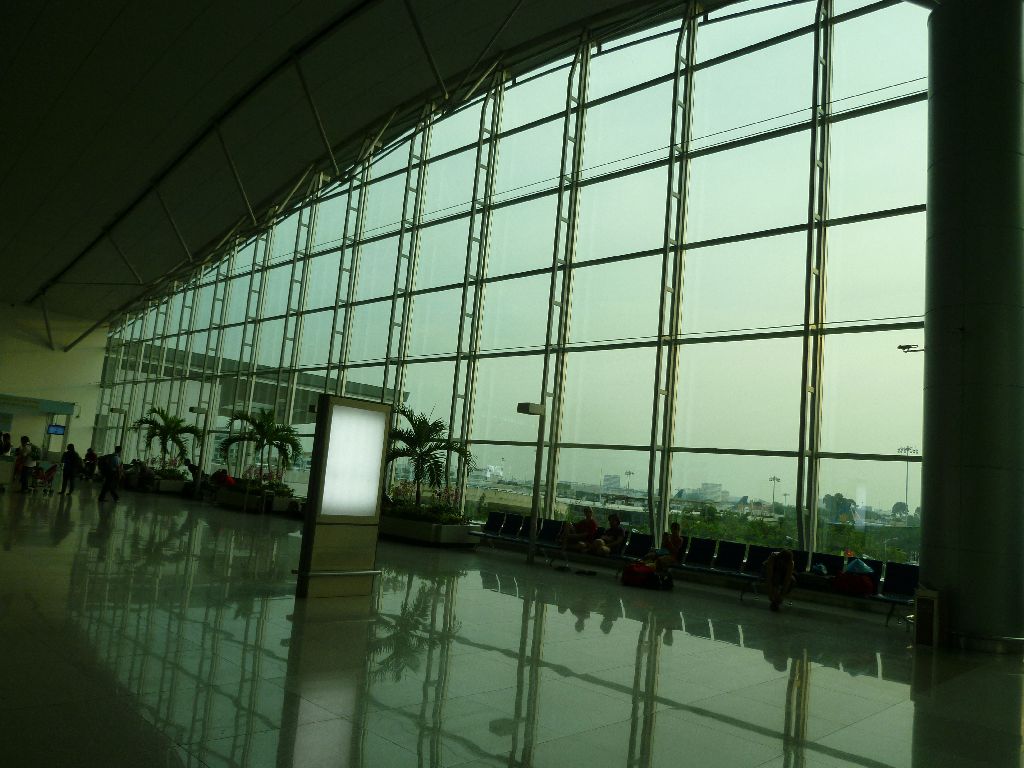
At most an ex-Cambodia Angkor Air aircraft now owned by VN

At 18:00, no problem to check in my luggage all the way to TPE and have a window seat. There too, I would need to get my boarding pass at NGO for the next flight.
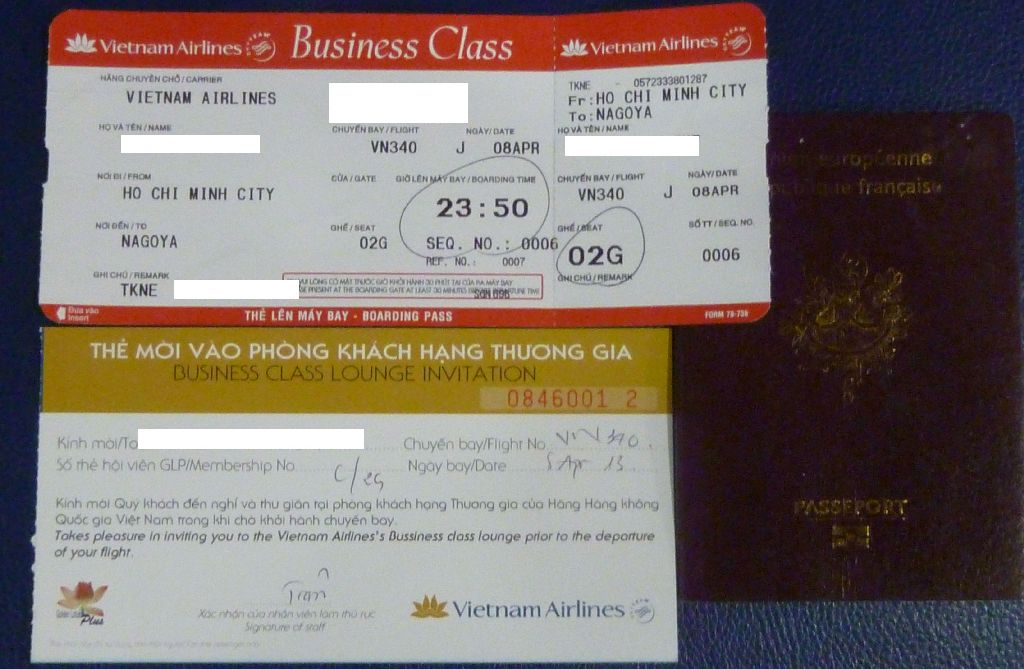
The policeman at immigration looked at me several times with a curious smile, without a single word. I had the clear impression that my traveler's resume as described by the origin and stamps in my passport did not match his idea of a traveler departing to Japan, but he eventually gave me the passport silently, with an enigmatic thin smile.
A cafeteria located airside provides an excellent view on the tarmac…
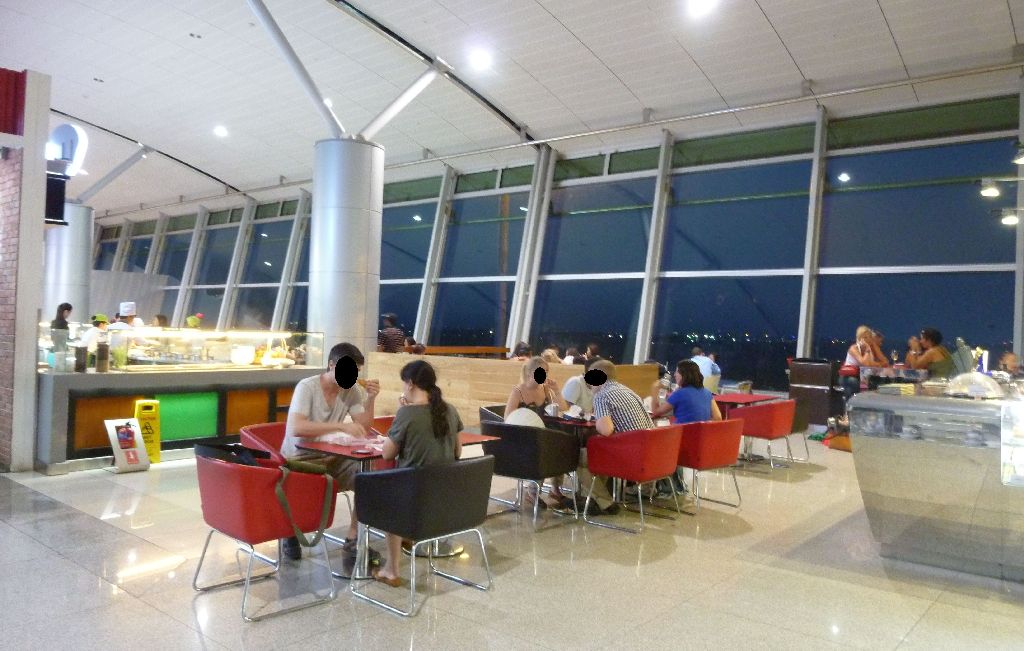
… but it was already too dark for taking pictures of taxiing aircraft. This picture of a Vietjet Air plane is the only barely acceptable one:

It was easier with planes parked pier side, but there was not much of a choice: a TK A340
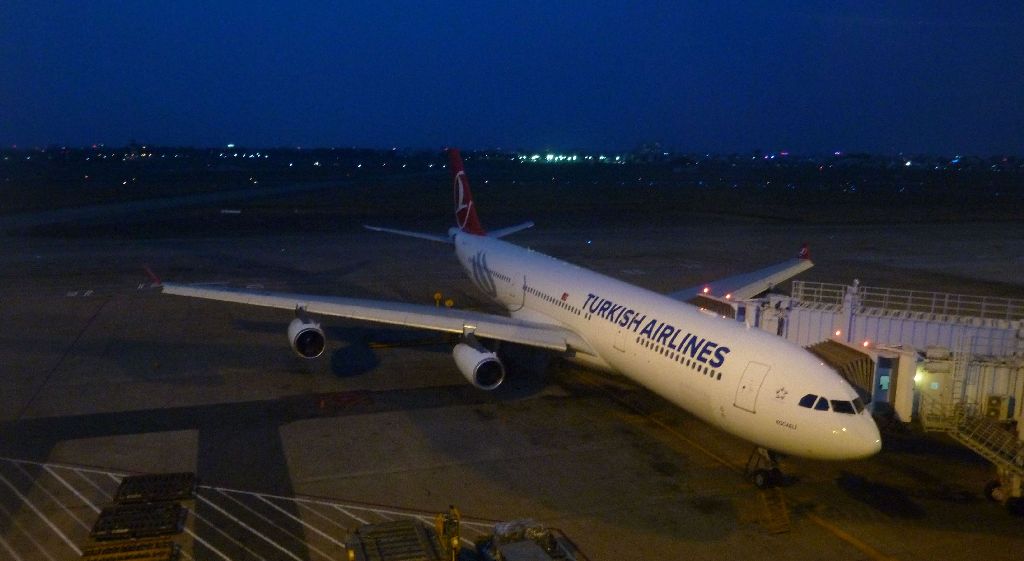
A CX A340

And an SQ 772ER

Last, an MH 737

This is what a boarding room looks like from one of the overhead corridors. They are very spotter-friendly as you can see.
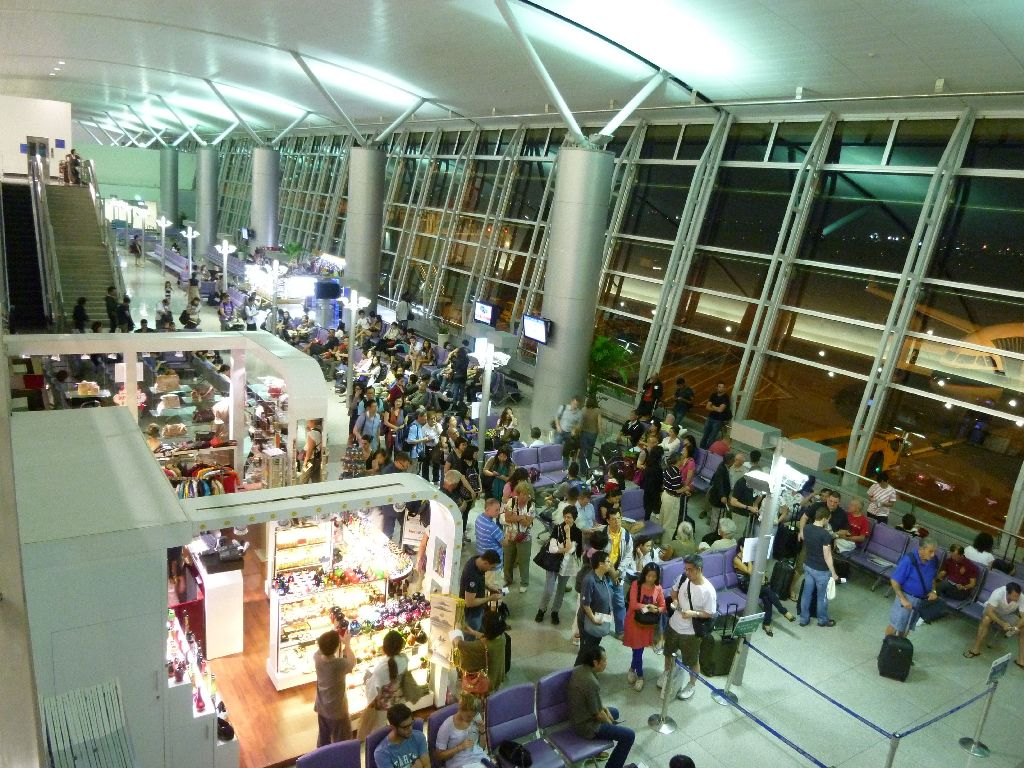
No kids' corner, a windowless smoking room of no use to me, and no other plane to spot: I head to the VN lounge.

You see here the quasi entire VN lounge and its occupants around 7pm. My arrival actually doubled the number of users, and only around 10pm did passengers stream in, but the lounge never felt crowded: nobody took a seat in my block of four.

I took a seat with a view on the TK aircraft

With quasi-zero passengers, I had zero constraint to take pictures of the buffet. It begins with a surprising discovery of bad taste:

Granted, the chopsticks are not waribashi, but the forks and knives are made of very cheap plastic, and the spoons of low quality metal. The slightly small tray has a university restaurant look, but it is convenient.
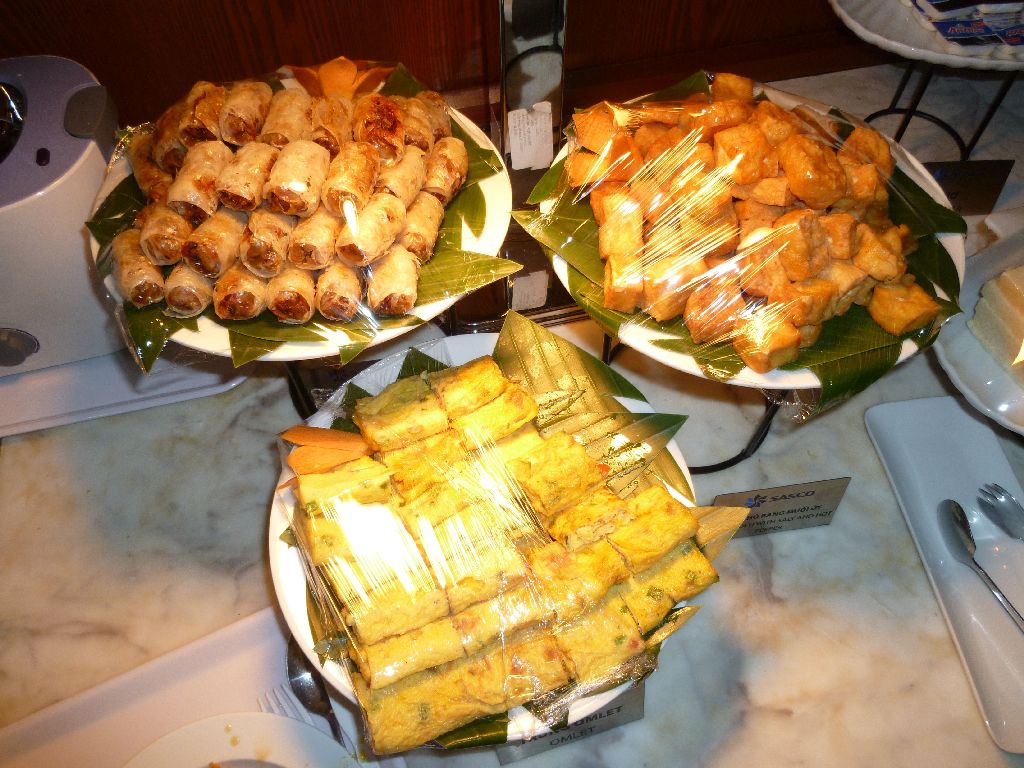
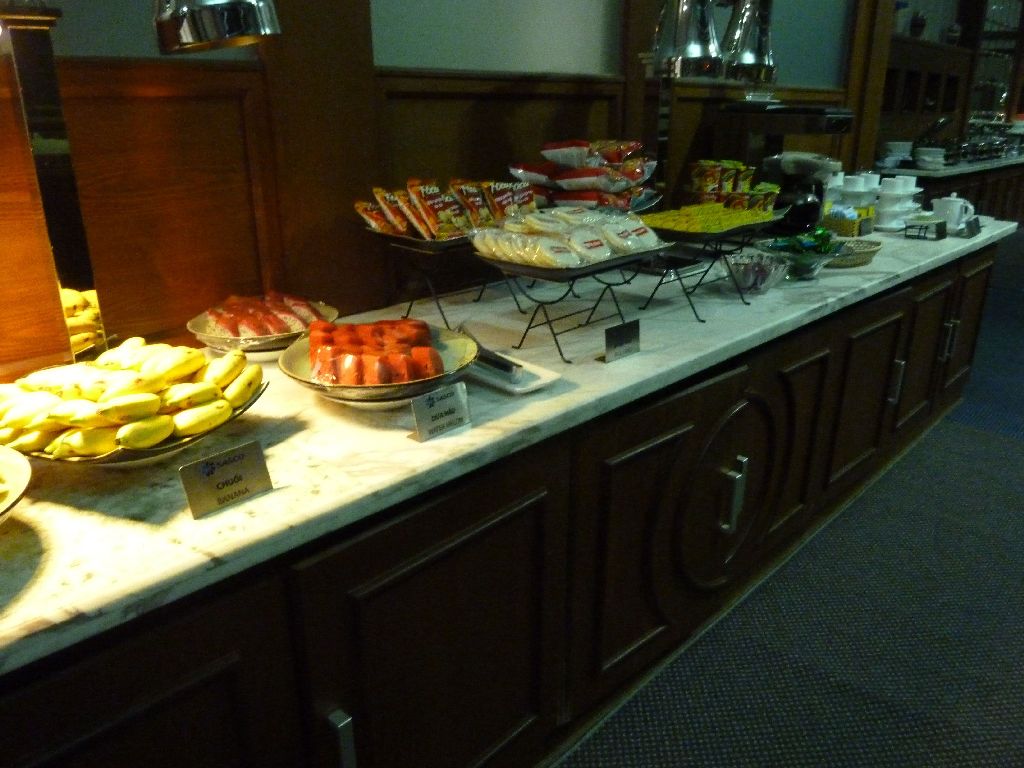
English labeling save me from commenting the dishes

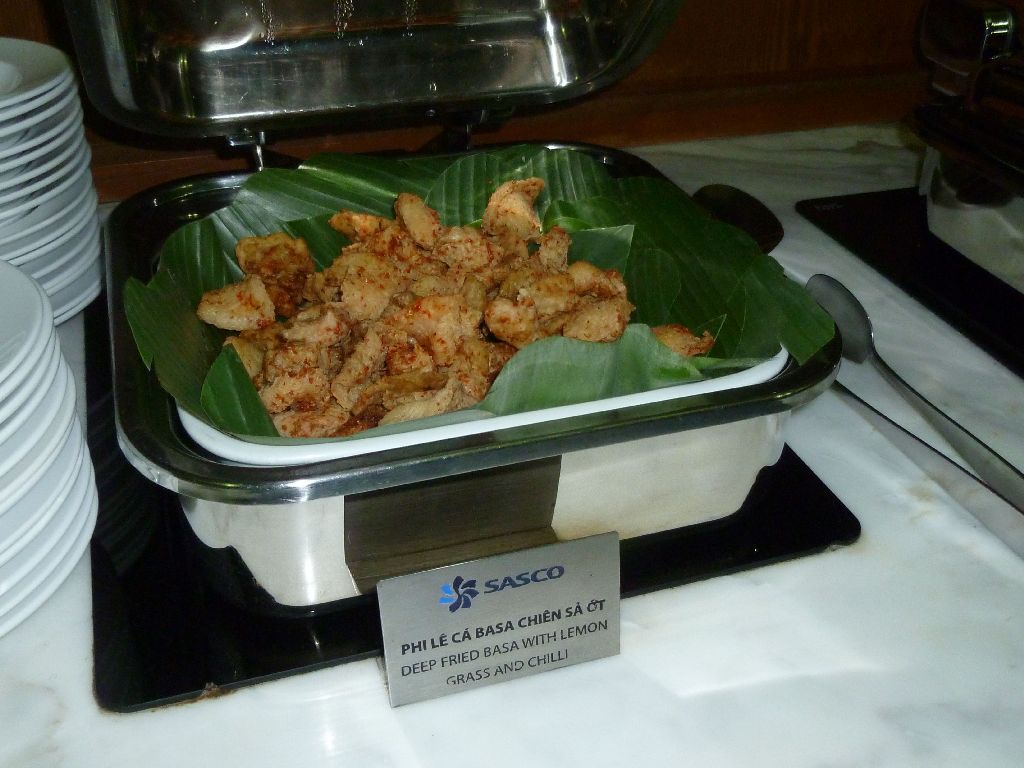

The egg of a Vietnamese hen looks amazingly like that of a Taiwanese or French hen.
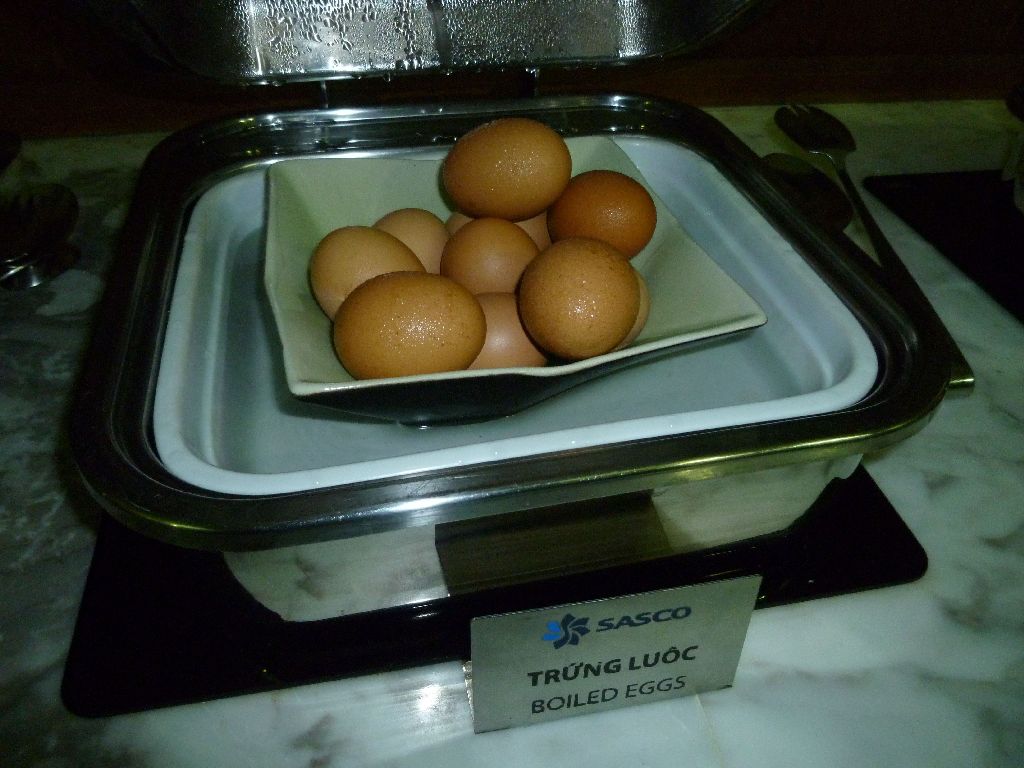
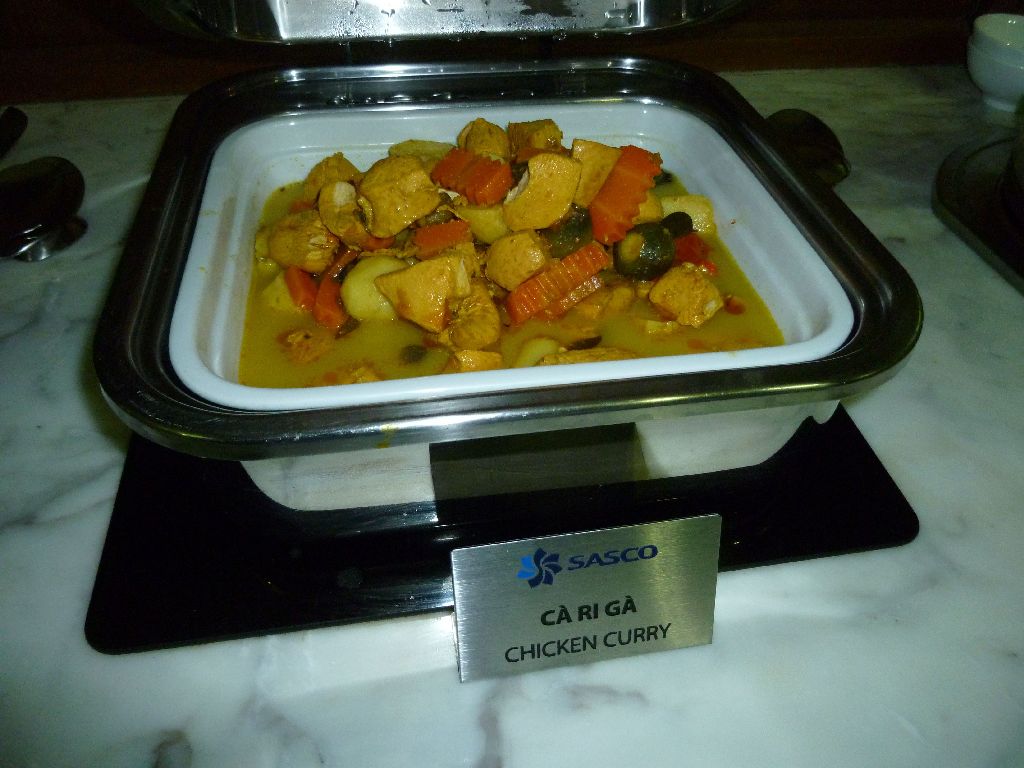

It is not very clear there, but there are spring rolls, pieces of omelette and sandwiches.
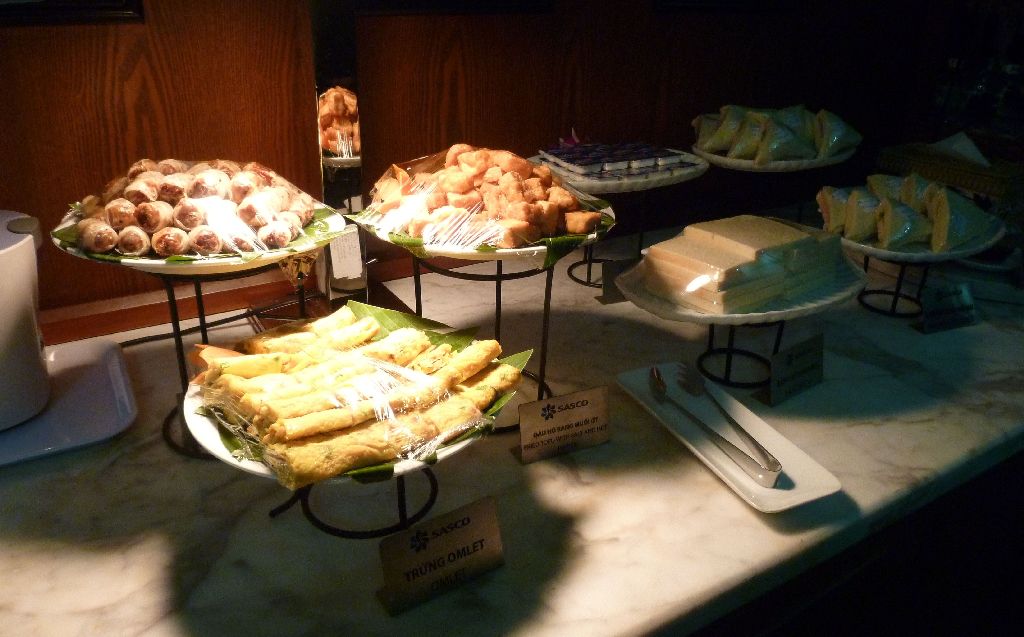
There had been so few passengers that the protective film was in most cases intact.
Nothing very exciting in the soft drinks sector


With regards to alcoholic drinks, there is a small wine cellar on the left…
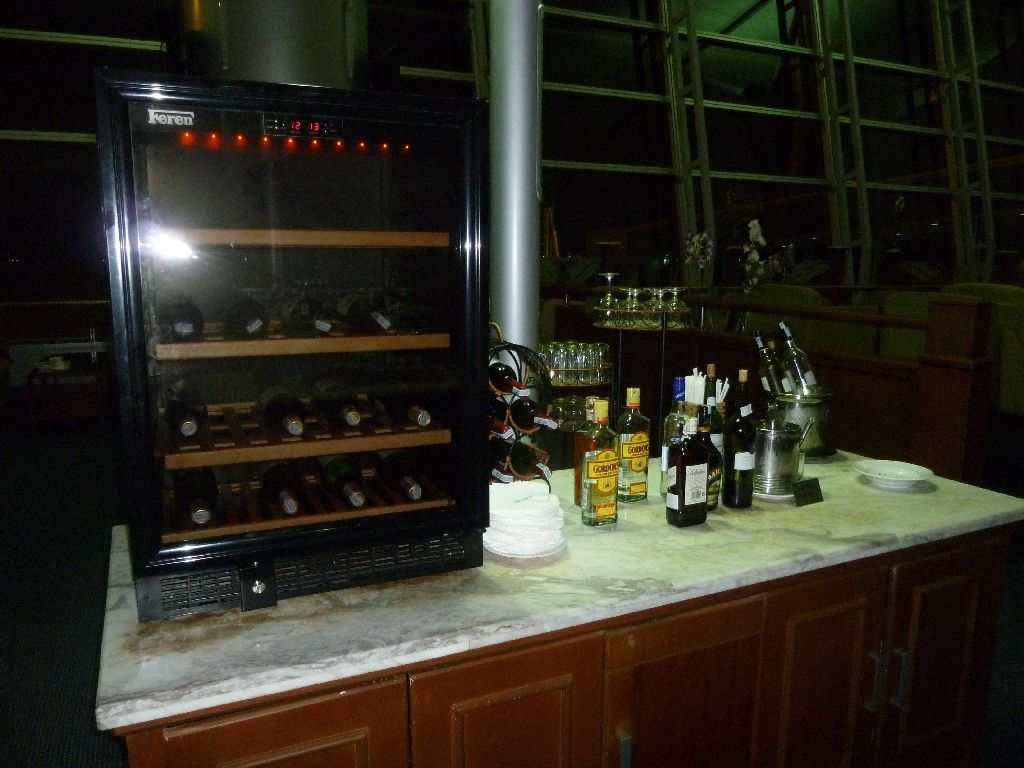
… which contains only two kinds of wine:

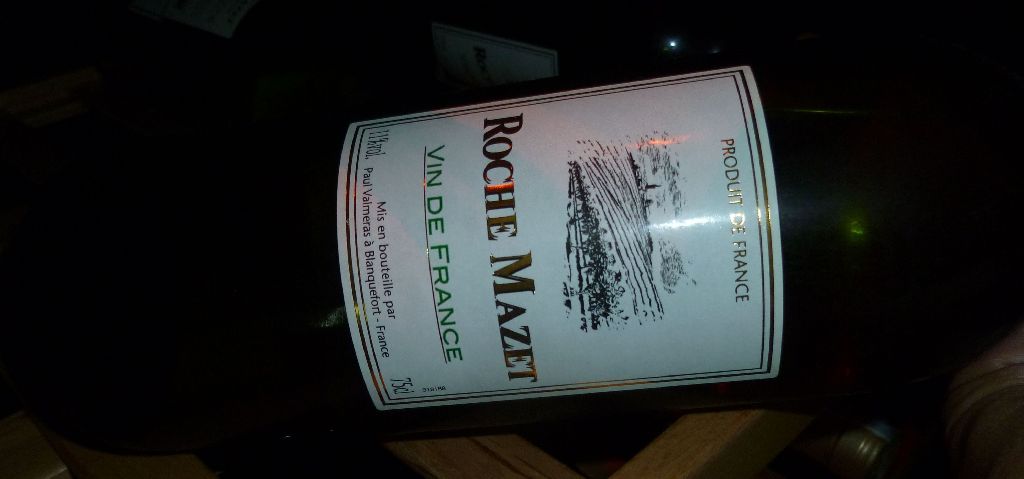
A few pictures of the other freely available wines and spirits. I am totally incompetent to comment upon their value.




This was my selection which could be summarized by some of each.

It was hearty food (which was a plus since I only had had a breakfast since 7am), but really disappointing from the taste point of view. I ate very tasty Vietnamese food during two weeks, and I expected much better from the flag carrier in the second largest city of the country.
Vn can prepare disappointing food, but the fruit cannot be fundamentally different from what they are elsewhere in the country, i.e. excellent. The coffee also is worth commenting.

In the distant past, when Aeroflot was the largest airline in the world and served CDG with TU-134s, when Estern Airlines was the largest airline in the free world and the first customer of Airbus in the US, when crossing the Iron Curtain with your own car was an adventure, the coffee that you could buy in a grocery of Plovdiv came necessarily from Eastern bloc countries, and therefore from either Nicaragua or Vietnam. The coffee from Nicaragua was expensive (because they could sell it in hard currency), and that from Vietnam was bad.
Nothing remains of that past: Aeroflot operates Airbuses, Eastern Airlines has disappeared, Europeans only need a national ID card to enter Bulgaria and the Vietnamese coffee has become good, and even excellent. It has an interesting vanilla taste and I drank liters of it during these vacations.

Even in VN's lounge, the coffee was in the post economic opening standard, i.e. excellent. My solvability in local currency being what it was, I did not try these massaging seats.

From the lounge or from the boarding gates, a taxiing aircraft (another Vietjet Air) can be reasonably photographed at night with my compact camera.

The toilets are neither large nor luxurious, but they are clean. I did not find showers.

With regards to newspapers and magazines, these are nearly exclusively Vietnamese media, including one in Chinese.

… with the exception of the Asashi Shinbun and the Chunichi Shinbun, the latter being appropriate when boarding a flight towards Nagoya where it is published.

The jet bridge moves away from an Air Asia A320

It will be pushed back while a TG 777 stops at the end of its pushback, giving me a picture opportunity while it does not move.

EK B777 departing to DXB

End of pushback

The pusher moves away


KE A330, to and from ICN

Just in order to show that there were some too, a blurry picture of a VN A330.

A last look at the lounge, to give an idea of the limited crowd of passengers leaving around midnight.

Bad news: the boarding gate is downstairs, which means a bus transfer, which by night does not provide any plane spotting plus.

The ground staff takes their workplaces quickly; and the usual priorities are respected.

Business class passengers are oriented towards a specific bus, which has many more seats for the same overall size, more seats than passengers, actually.

Like in DAD, it is registered with the IATA code of the airport, in white on a blue background because it is a government vehicle.

The economy class passengers board a standard bus

It is a short ride to that A321

The business class bus left first, and since it was not that full, I had the opportunity to use the stairs as a makeshift stand for my camera.
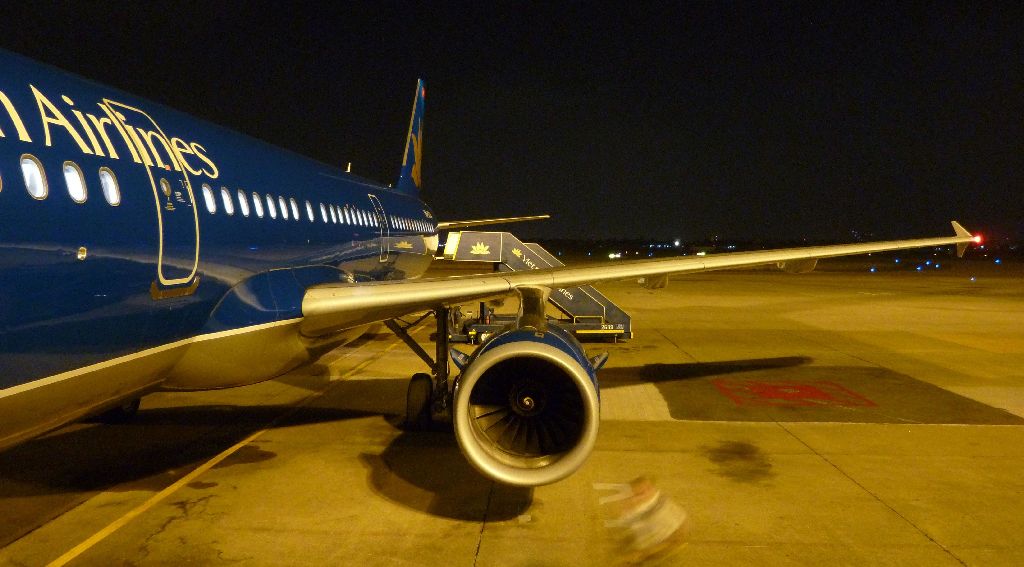

It is confirmed that VN is part of Skyteam

This is what the J cabin looks like: four rows in 2+2 layout, with few passengers on that flight (5 or 6, I forgot)

I did not use this blanket, and I found the cushion comfortable

Seen sideways or with the usual knees' picture, the seat pitch is comfortable no matter the size of the traveler.
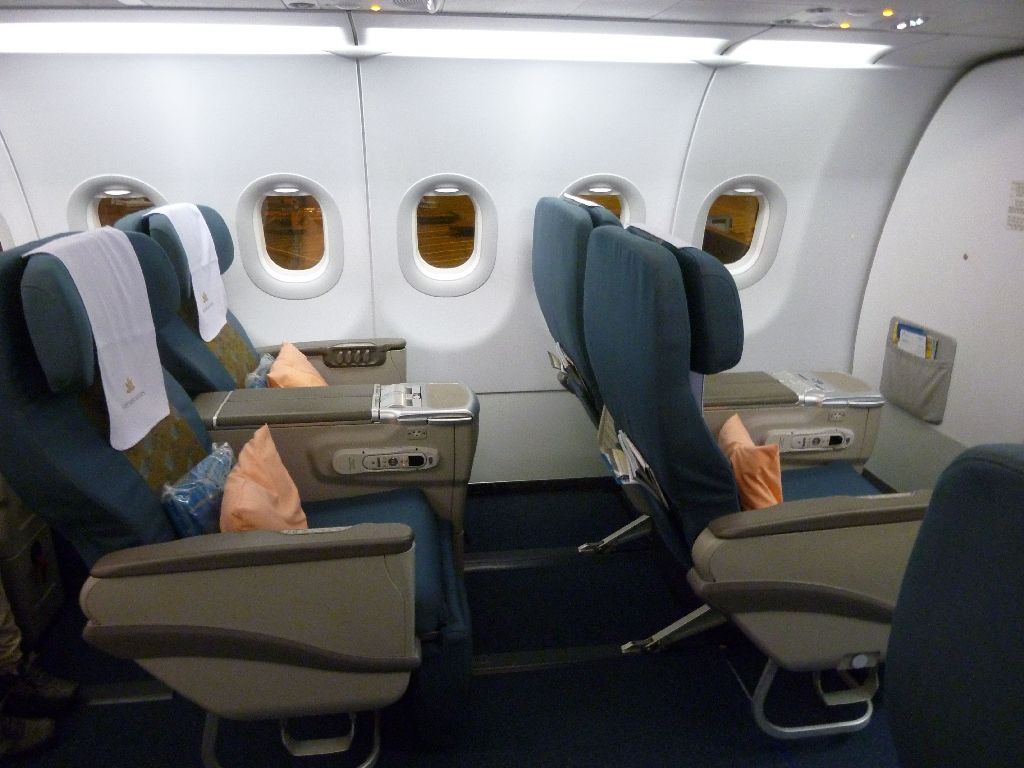
Good thing, because there is a very bulky technical (IFE?) box under the window seat and the central space.

The seat is reasonably comfortable, but does not recline much. It is really a regional business class seat, and I was afraid to sleep poorly in what reminded me of AF's Espace 127 seats of my youth. In fact, I was so tired I could have slept anywhere.
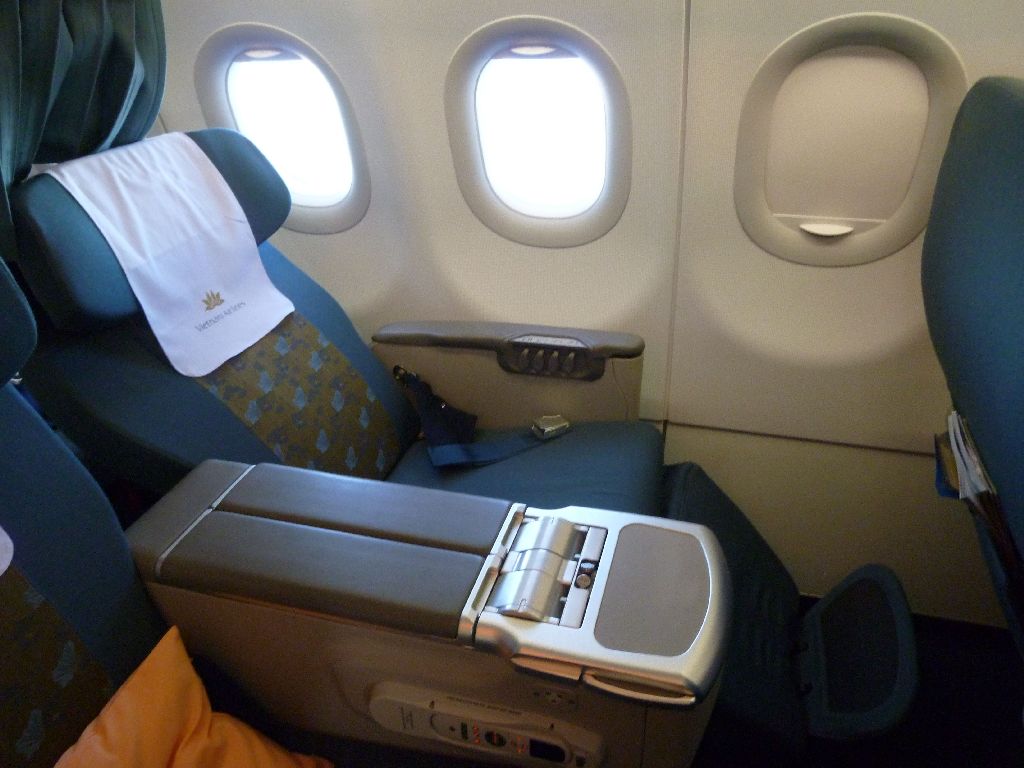
That seat is nevertheless archaic, with non motorized controls. The seat unlocks suddenly when you want to straighten it up, and you need some strength to move the lower part of the seat.
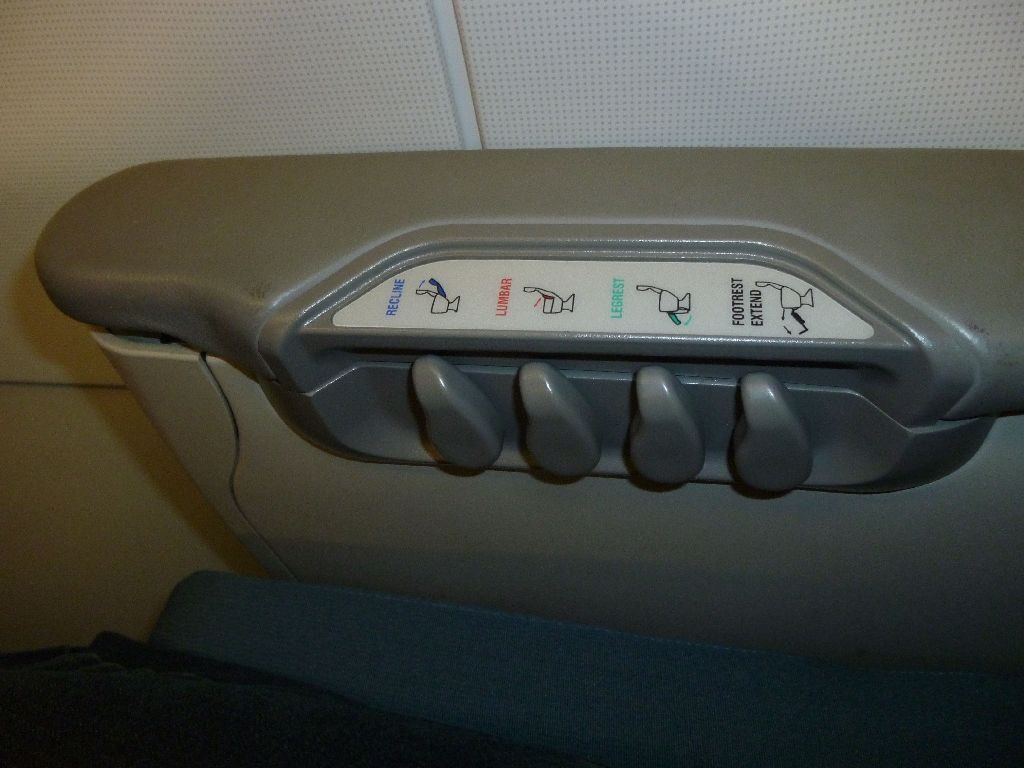
The safety demonstration is done the old fashioned way, the English part being read with some difficult by a FA in the front of the aircraft.

The plane takes off after midnight: it makes sense not to serve dinner, only a drink, and I actually went to sleep before the one I had ordered was served. Breakfast is served two hours before landing, which I found much too early, especially with so few passengers in business class, because I wish I could have slept an extra half hour. But it did give me the opportunity to see the sunrise. Sorry, my picture of the menu is barely legible.

Takeoff, with two views of Saigon at night, just to show that the airport has been caught up by the urban sprawl.
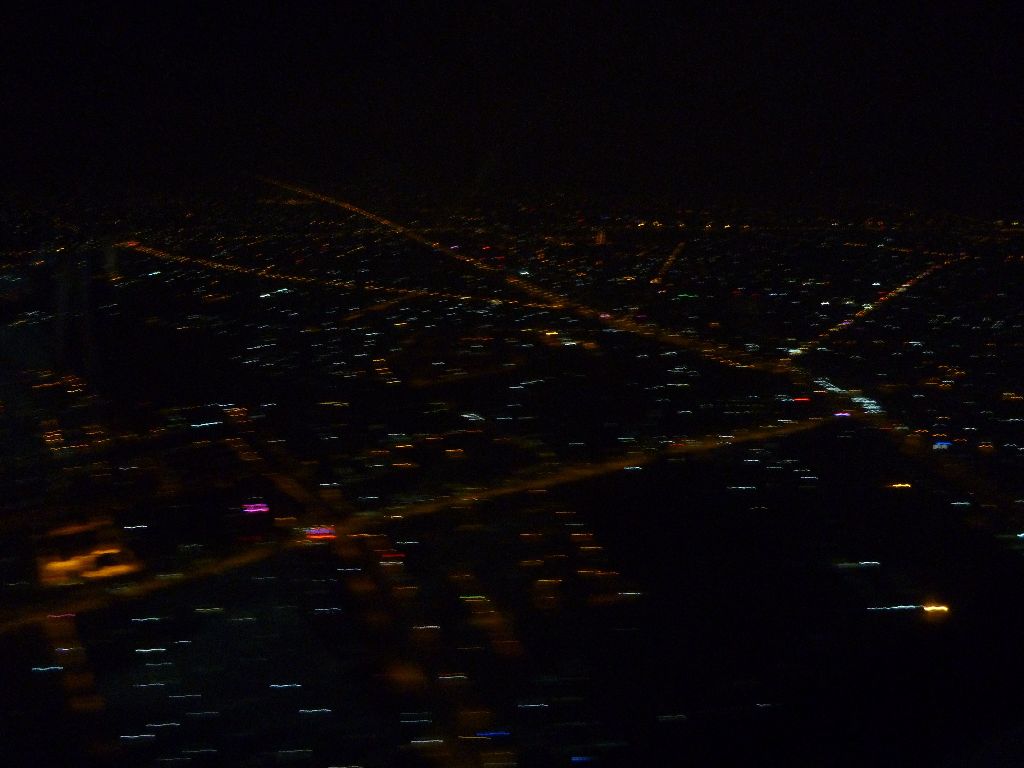
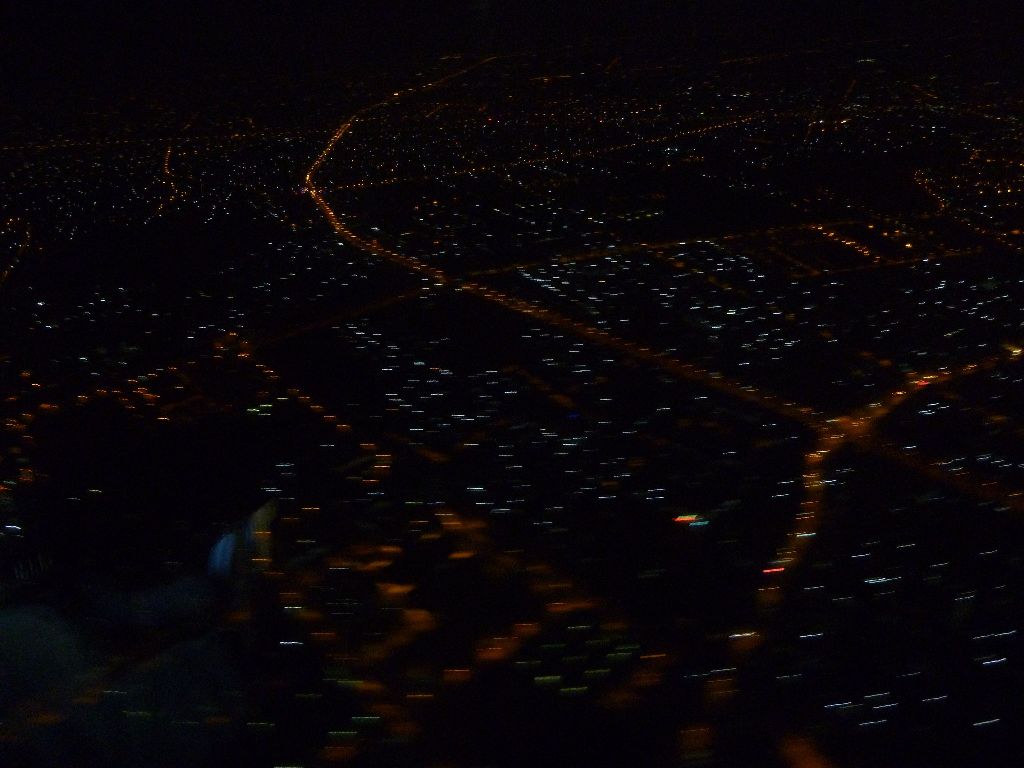
The contents of the courtesy kit are very standard. The soft pouch is of good quality and is reusable. There is a foldable combined hairbrush and comb seen on other airlines recently.

A cold oshibori (normal, when it is hot outside), and a non-descript glass of orange juice.

I then got to sleep, and was awaken by the setting of the breakfast.

I chose the Japanese option: good, but not outstanding. On the top right, the coffee is Vietnamese, therefore good. I chose this croissant from a selection of pastries.

Being awaken too early got me to see dawn. You won't escape sun lighting effets on my FRs to or out of SGN.





Never forget the winglet!

Since I do not have a neighbor, I could move around. An unusual view of the economy class:

… and the rear wing, from a free window seat on that side

The same, somewhat later.

The toilets are A32x, with the addition of these flowers.

And liquid soap, minus deodorants. The baby changing board has a female pictogram.

What else could I do on that flight? Explore the IFE's offering. It is inside the central armrest, therefore a little bit small.

The geovision does not show the position of the aircraft on the route, which makes it much less useful.

Or should measure the distance on the map?

Games? No, there is none.

The audio offering is equally disappointing. For classical music, there are only two CD. I find these grand adjectives utterly ridiculous.

So we have Beethoven's first four symphonies
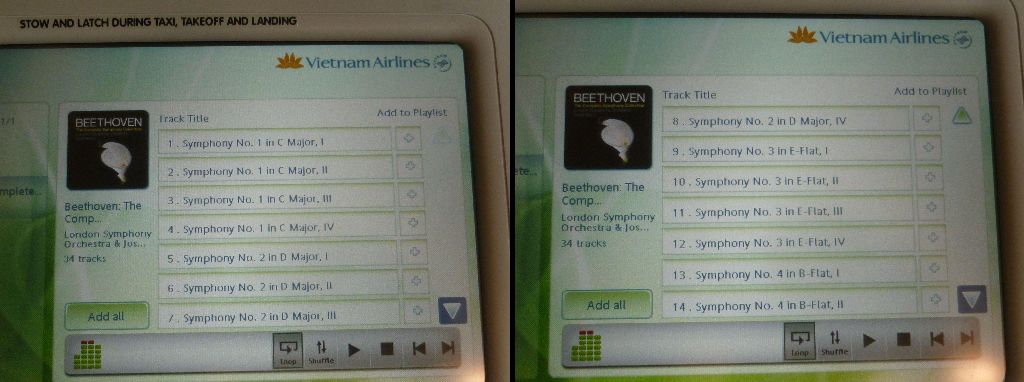
And a mix of favorite excerpts of classical and not so classical music pieces. It is so disparate that after Purcell (1694) at number 11, you jump to Rogers & Hammerstein (1951) at number 12… and there is no mention of the names of musicians.

The headphones look cheap, but I found them comfortable to wear and with an acceptable audio quality. The single use adaptators in contact with the user's ears were somewhat difficult to put in place.

The controls are either on the tactile screen (easily reachable, but slow), or with the remote control in the central armrest.

I did not check the available movies (I never watch movies when I fly), but the choice of audio channels was really below standards.

Some views of Honshu during descent:

Remaining snow on mountain tops of the Kii peninsula



The small Aiga ans Owase harbors, on the east coast of the Kii peninsula
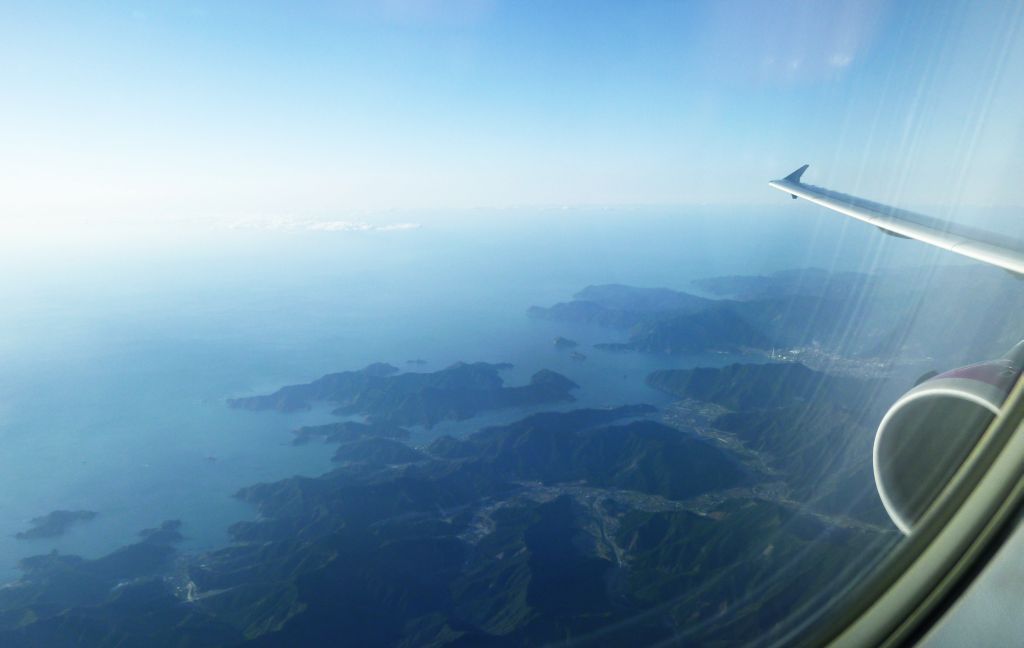
Again the Kii peninsula mountains

The cabin is being prepared for landing. In the first row of the economy class, you can see a father and sleeping son, and I could hear the cries of the daughter on her mother's lap on the other side of the aisle.


I wonder if the Nishiki harbor is as pretty from the ground as from the air?

Ise, and the outlet of the Miyagawa river

Too bad there were some waves, because the plane's shadow passed precisely on that cargo ship.

On the other hand, there are no waves on the ground, and the plane's shadow is all the sharper that there is a bright blue sky in NGO.


Kiss landing minus a few seconds

Several aircraft seen in the distance during taxiing (not a long one, because NGO is a rather compact airport)
CRJ-700, Ibex Airlines

Dash 8, ANA

Tsunami special livery for that JAL Express 738: the Japanese below is difficult to translate, but means something like Cheer up, Japan!
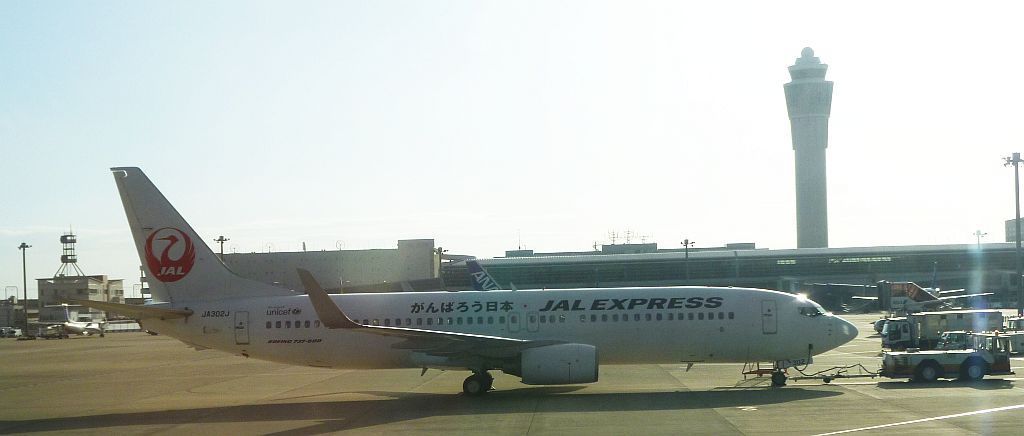
We arrive pierside next to that CZ A320


And I feel some emotion seeing in the distance an unusual aircraft with a characteristic shape.

It is one of the four Dreamlifters, whose transformation from second hand 747s was done by Evergreen Aviation Technologies in TPE.

This TG 773 which landed just after us looks ordinary in contrast

In the corridor leading to the connection counter, I see this sign which reminds me that I am back in my favorite part of Asia, the one which uses ideograms.

This is the end of this FR – that of the connecting flight will be posted soon.
You can scroll down to the conclusion if the tourist bonus on the Mekong delta does not interest you.
The Mekong delta is an incredibly dense and intricate network of river branches and canals, some very wide and others quasi invisible, even from a close up. In Can Tho, the main city in the delta, there is a ceaseless traffic, even though this is a very minor tributary of the Mekong.
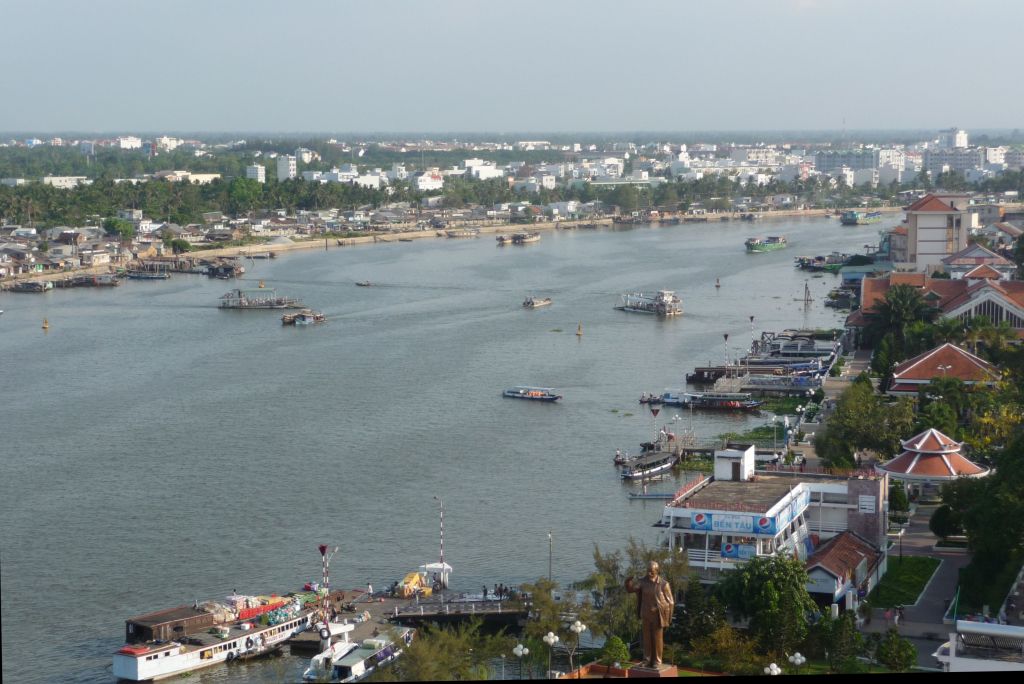
In order to improve communications in this region where waterways – very cheap, but very slow – are the prime means of communication, the Vietnamese built a series of bridges on Highway One, which until now was cut by a succession of ferry crossings. You can see on the far left one of the pillars of the Can Tho viaduct, on one of the distributaries of the Mekong.
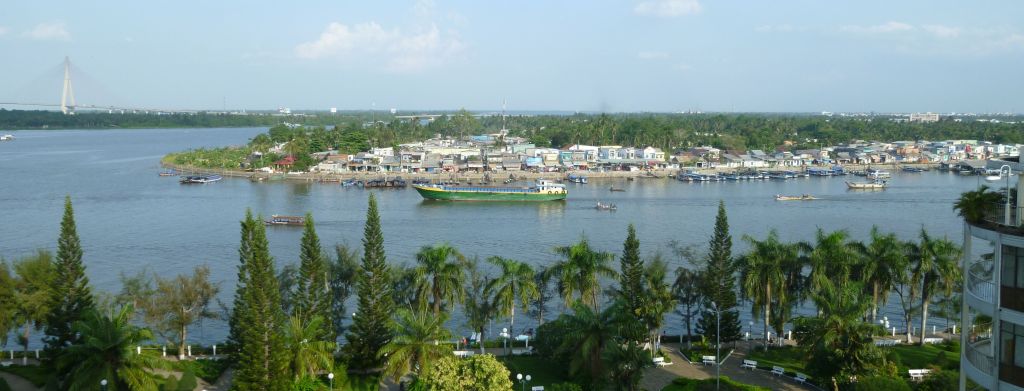
The Can Tho viaduct is the most spectacular of these bridges. Its 550 meters long central span holds the record in South-east Asia, and its 39 meter clearance is compatible with any boat on the Hau Giang, the Mekong distributary that it spans. It also was the most deadly construction project in Vietnam, and the Japanese builder erected a temple nearby in the memory of the 52 victims of the collapse of one of the landside spans of the approach ramps.

Where there is no bridge, there are ferries, and those at Long Xuyen are remarkably efficient. See the landing : there are five berthing positions on the sides of an octagon.

At any time, there are three ferries at various stages of loading and unloading of two-wheel or four-wheel vehicles and pedestrians.
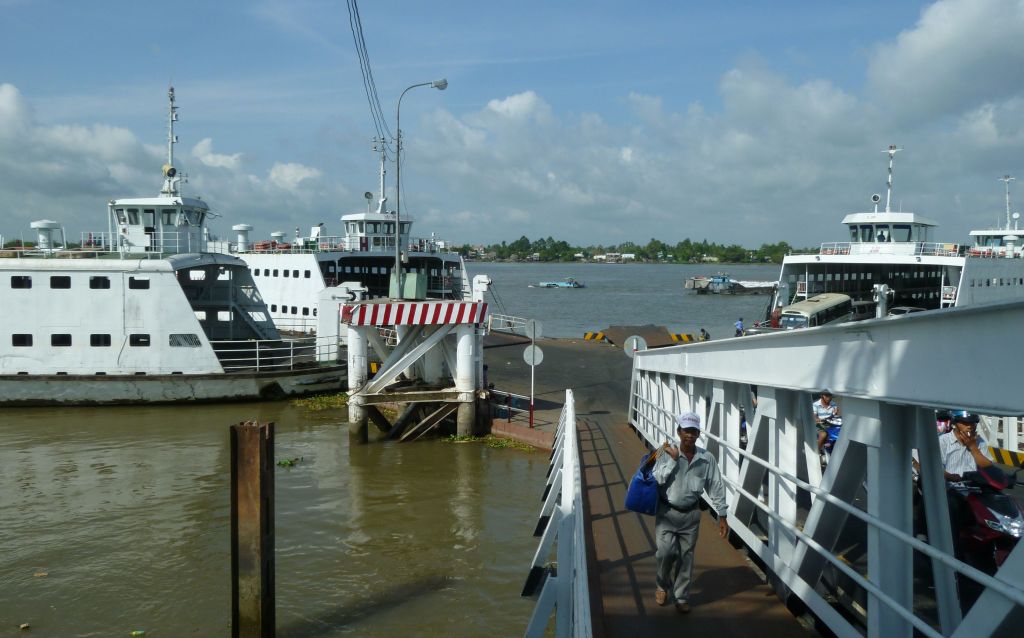
Better say that those who sell fruit, cigarettes, chewing gum and similar goods must hurry up, because the crossing takes only six minutes.

I guess the envy of my readers when I reveal that I spent a night in Long Xuyen (Wikipedia : Each year, many tourists pass through Long Xuyen, on their way to Chau Doc, which is a major stop-over on the way to Cambodia. However, tourists rarely stay in Long Xuyen ), in order to visit the mausoleum of Ton Duc Thang, the first president of the Socialist Republic of Vietnam.
Not only does this give me the opportunity to show a kids' corner which was missing in SGN …

… but you also spotted like me through the trees the silhouette of a Yak-40 in mint condition.

It was the time when the Vietnamese airline was called Hang Khong Vietnam (another example of a Vietnamese word originating from Mandarin: VN is called Yuenan Hangkong in Mandarin); the plane registered VN-A552 is historic, because it is the one which flew Ton Duc Thang from SGN to HAN in 1975 for his induction to the rather honorific position of President of the Republic.

Unlike the earlier Yak-40 types, this one was equipped with thrust reversers; you can also see the fuel dumping outlet above reactor number 2. Like the 737 and the E-jets, the Yak-40's main landing gear remained visible when it was retracted.

The late Marguerite Duras is a local celebrity, because she lived in the delta in her youth, and that is where the first foreign major movie was shot after the country's unification, based on her autobiographic novel The Lover. It was shot in that house, which since generations belongs to the same family,

… whose frail white-haired descendant guides visitors of the main room.

The film has not been entirely shot in Vietnam: the torrid scenes have been shot in studio in Paris, mostly with understudies. These scenes have all been censored in the version distributed in Vietnam, and the censorship has been so prudish that a Vietnamese told that he understood nothing of the plot when he saw the movie.
Although Marguerite Duras never revealed the name of her lover, he has been identified as being Huynh Thuy Le, the son of a wealthy Chinese family whose house in Sa Dec is also open to visitors.
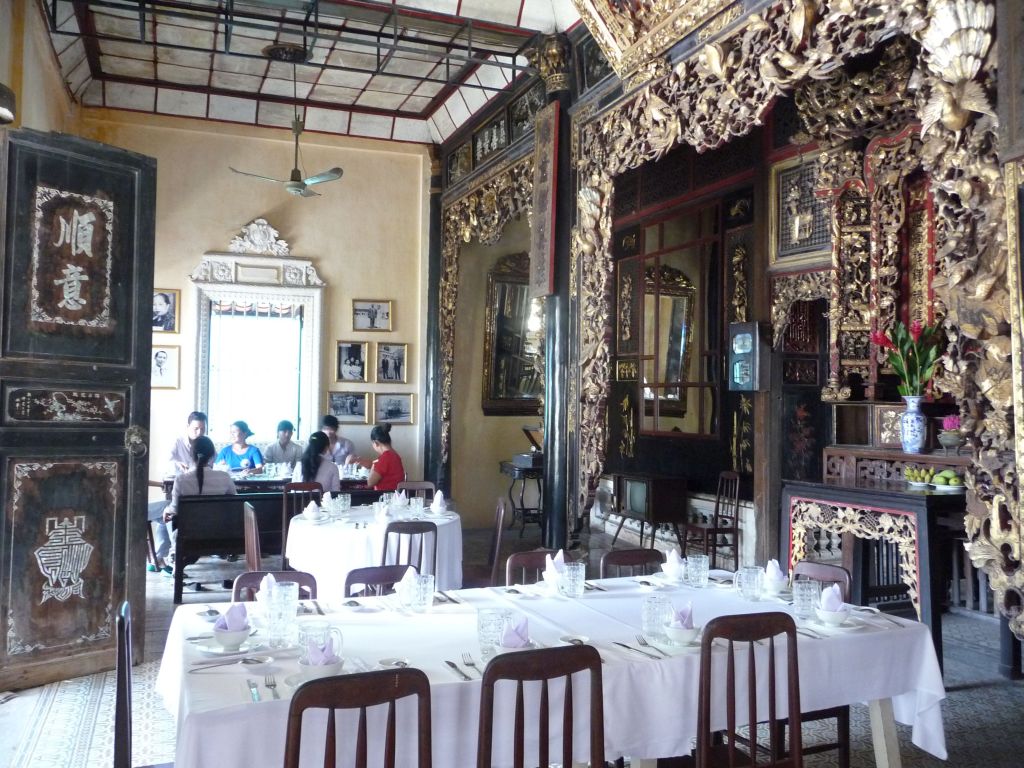
The market in Sa Dec is similar to all others in the Mekong Delta, with all kinds of vegetable, fish and seafood.

And also in the foreground this mouth watering vat of freshly skinned rats. They were on the menu of the restaurant and I admit I chose snake instead, whose taste was unusual and interesting. You should not think too much about the cold chain in this region where the temperature was routinely 35°C in the shade.
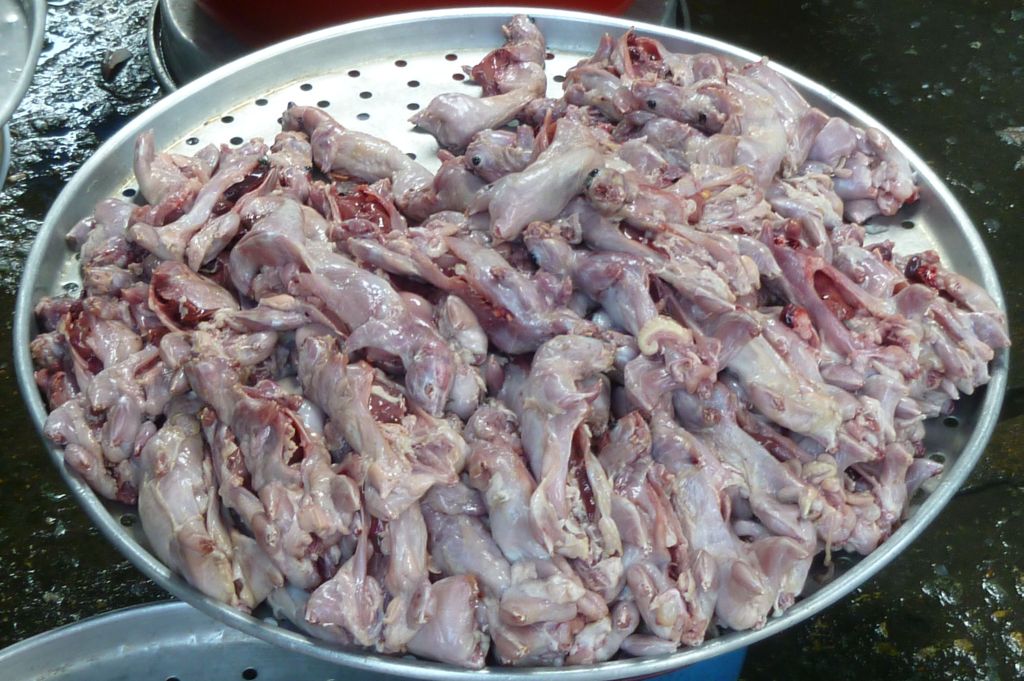
The Mekong delta is also the best place in Vietnam for seeing young Vietnamese girls wearing an ao dai, this long tunic slit on both sides up to the waist. It is even the uniform in many schools of the delta
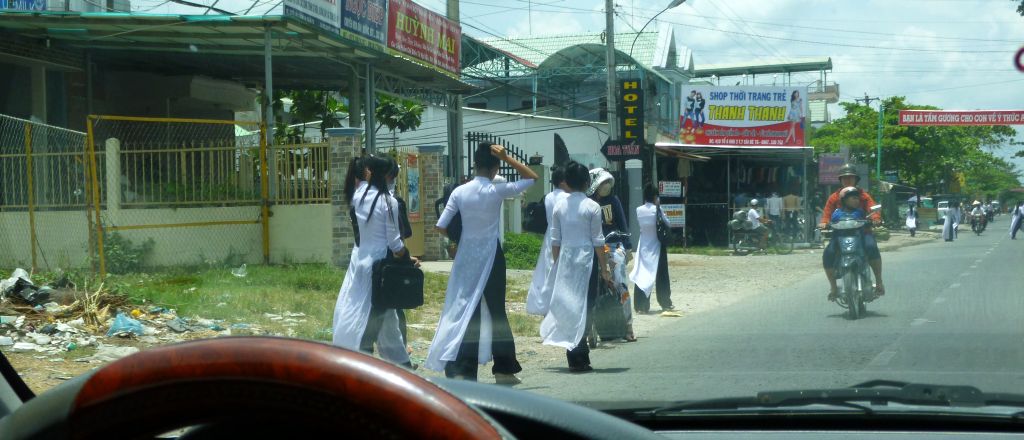
… and you can see at lunch time high school students heading home on foot or on a bicycle, with a mask on the face to avoid tanning.

The ao dai, which according to the Vietnamese themselves covers everything and hides nothing is also the uniform of many employees, like here in a rest area's restaurant on Highway Number 1.
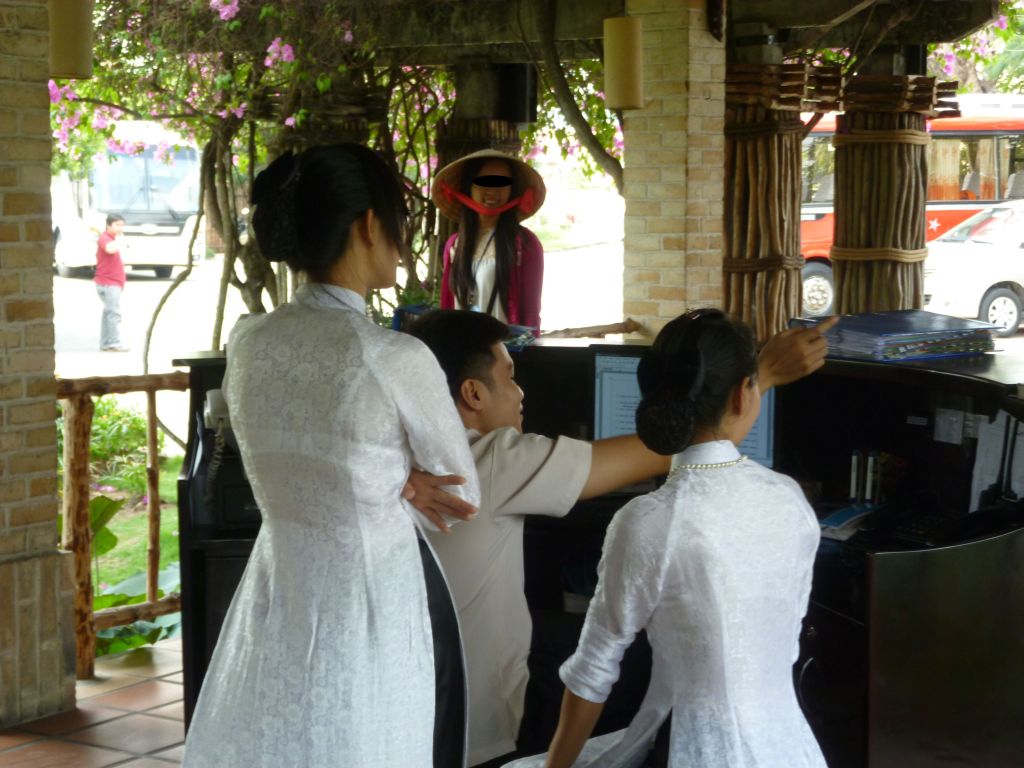
It is a pleasure everyday, but for the eyes only, for this beautiful lady wears a wedding ring !

It is at long last the end of that FR, thank you for reading it; do not miss the connecting flight to TPE!
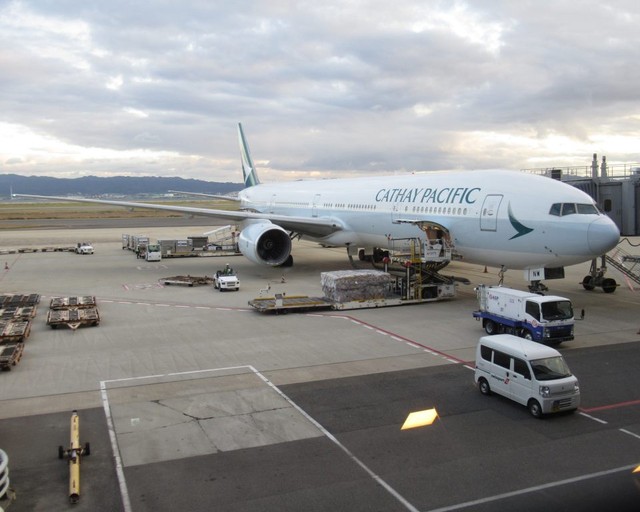
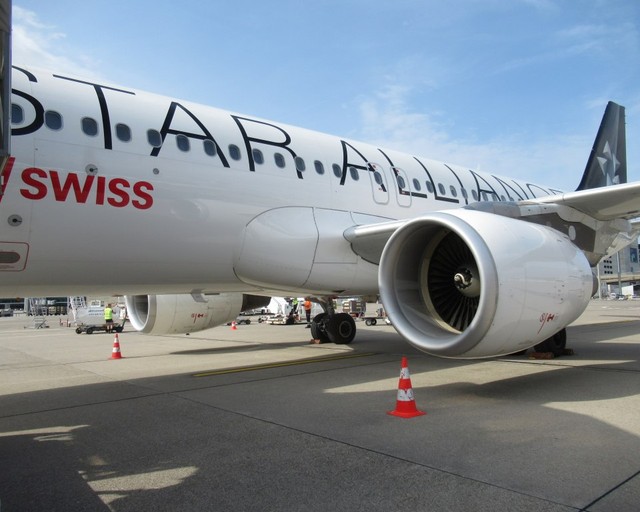
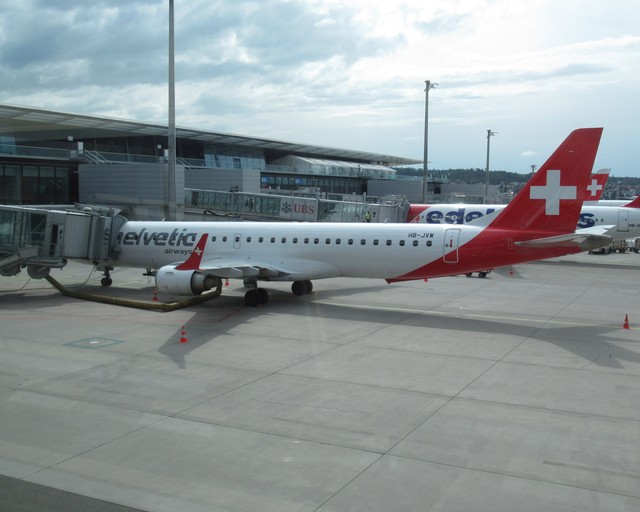
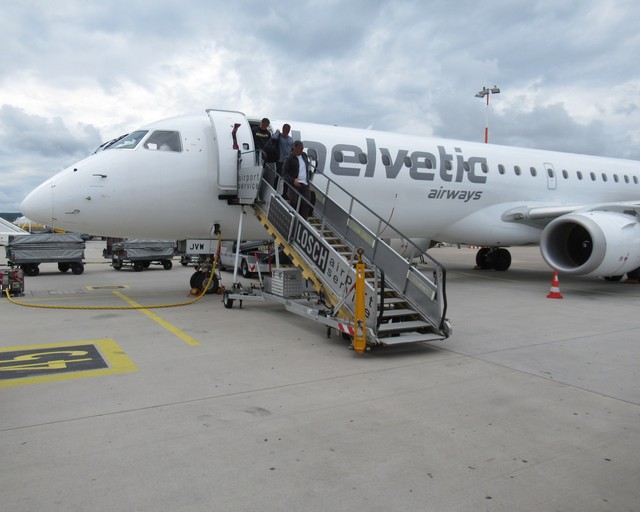
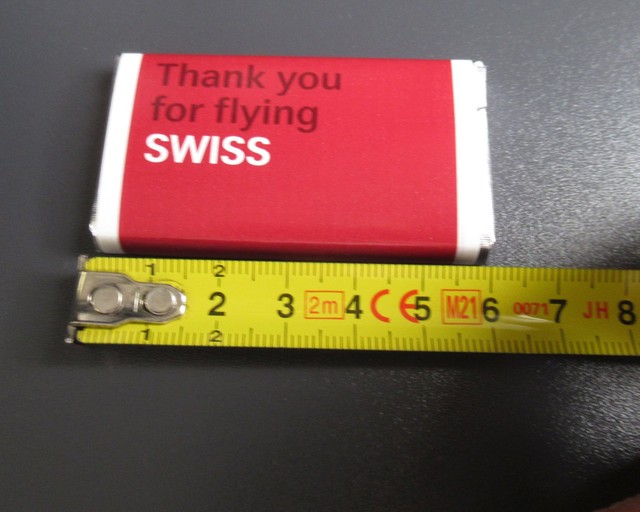
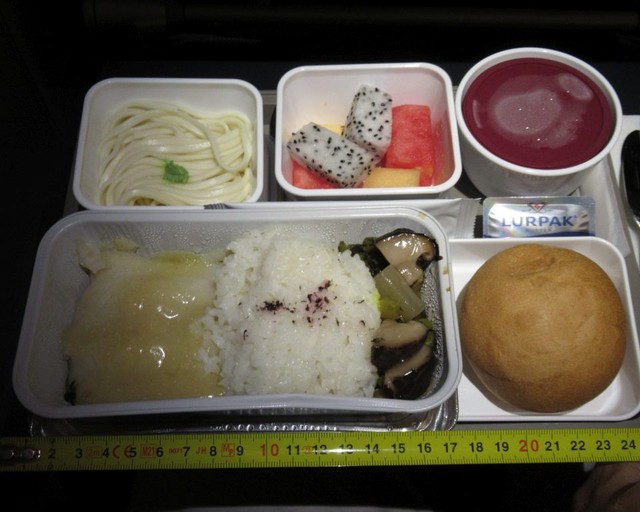

Hello,
Nice FR.
I suppose this is a translation of a previous FR you have already posted a while ago.
I really have a sweet tooth for VN liveries. The planes are beautiful.
I agree the VN dark blue livery is striking. This is indeed a translation of my original report in French. Thanks for your comment!
Well thanksa lot then.
There are so many FR to read and so many that I've missed.
The good points of recycling I guess.
Lovely report! Thank you.
Thanks for the comment :)